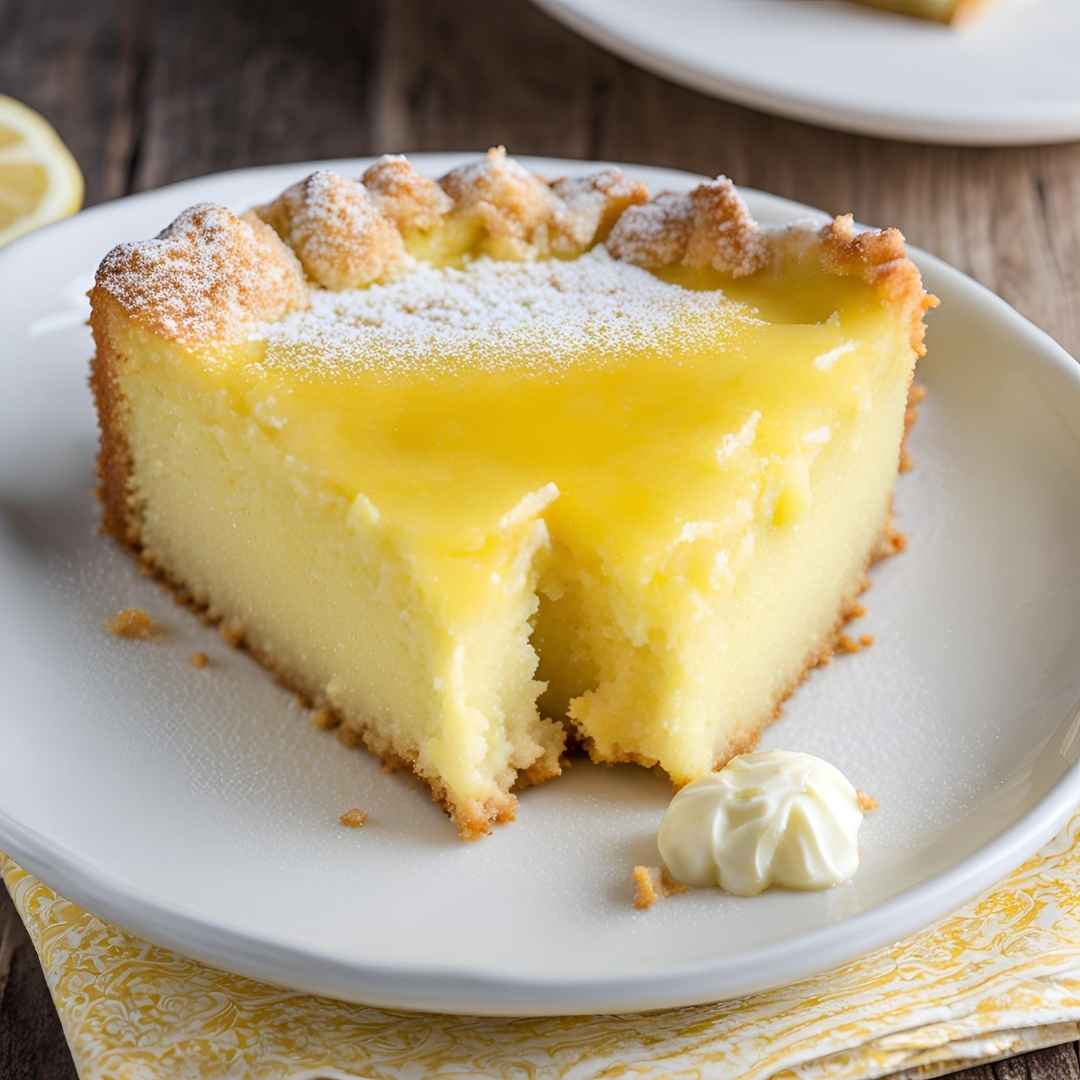Lemon custard cake is a luscious dessert that combines the zesty brightness of lemon with the creamy texture of custard and the lightness of cake. With its layers of soft sponge and silky lemon custard, this cake offers a delightful balance of tart and sweet, making it a perfect treat for all occasions. Whether served at a sophisticated gathering or as a comforting homemade dessert, lemon custard cake is sure to impress with its elegant flavor and irresistible texture.
The History of Lemon Custard Cake
The origins of lemon custard cake lie in the rich tradition of citrus-based desserts that emerged during the height of European culinary innovation. Lemons, once a luxury ingredient, became a favorite in desserts due to their vibrant flavor and aromatic appeal. Custard, a culinary classic dating back to ancient Rome, has long been a staple in sweet and savory dishes alike. The idea of combining these two elements into a single dessert is a testament to the creativity of bakers aiming to achieve the perfect harmony of flavors and textures. Over time, lemon custard cake gained popularity as a versatile dessert that could be enjoyed year-round, from sunny summer picnics to cozy winter evenings.
Ingredients Breakdown
- Lemons: Freshly squeezed lemon juice and zest provide the bold, tangy flavor essential to this dessert.
- Eggs: Serve as a binding agent and contribute to the custard’s silky texture.
- Granulated Sugar: Balances the tartness of the lemon and adds sweetness to the custard and cake layers.
- Butter: Adds richness and moisture to the cake while enhancing the lemon flavor.
- All-Purpose Flour: Provides structure to the cake layer.
- Milk: Creates the creamy texture characteristic of the custard layer.
- Powdered Sugar (optional): For a decorative dusting on top.
Step-by-Step Recipe
- Preheat and Prepare: Preheat your oven to 325°F (165°C). Grease and line an 8×8-inch baking dish with parchment paper for easy removal.
- Separate the Eggs: Separate egg yolks from whites. Place the whites in a clean, dry bowl for whipping later.
- Mix the Batter: In a large bowl, whisk egg yolks, sugar, and melted butter until smooth and pale. Add lemon zest and juice, mixing well. Gradually stir in flour until fully incorporated. Slowly pour in milk, whisking until smooth.
- Whip the Egg Whites: Using an electric mixer, beat the egg whites until stiff peaks form. Gently fold the whipped whites into the batter, being careful not to overmix. The batter will be light and airy with visible streaks of egg whites.
- Bake: Pour the batter into the prepared dish and bake for 40-50 minutes or until the top is golden and set. The cake will have distinct layers: a fluffy cake layer on top and a creamy custard layer beneath.
- Cool and Serve: Allow the cake to cool completely in the pan before slicing. Dust with powdered sugar if desired and serve chilled or at room temperature.
Tips for the Perfect Lemon Custard Cake
- Use fresh lemons for the best flavor; bottled lemon juice lacks the brightness and zest of fresh fruit.
- Ensure the egg whites are beaten to stiff peaks for a light and airy top layer.
- Fold the egg whites gently to maintain the batter’s airy consistency.
- Allow the cake to cool fully before slicing to prevent the custard layer from oozing.
Variations and Customizations
- Orange Twist: Substitute lemon with orange juice and zest for a sweeter citrus variation.
- Berry Addition: Add fresh blueberries or raspberries to the batter for bursts of fruity flavor.
- Gluten-Free Option: Use a gluten-free flour blend to cater to dietary preferences.
- Lavender Infusion: Add a hint of culinary lavender for an aromatic twist.
Health Considerations and Nutritional Value
Lemon custard cake, while indulgent, provides some nutritional benefits from its lemon content, which is rich in vitamin C and antioxidants. However, it is high in sugar and fat, primarily from butter and eggs. For a lighter version, consider using low-fat milk, reducing sugar, or substituting some butter with unsweetened applesauce.
FAQ
- Can I make this cake ahead of time? Yes, it tastes even better the next day after the flavors have melded. Store it in the refrigerator for up to three days.
- Can I freeze lemon custard cake? Freezing is not recommended due to the custard layer’s texture change upon thawing.
- What’s the best way to serve this cake? Serve chilled or at room temperature, optionally garnished with powdered sugar or whipped cream.

Lemon Custard Cake
Ingredients
- 4 eggs at room temperature, separated
- ¾ cup granulated sugar
- ½ cup unsalted butter melted and slightly cooled
- 1 teaspoon vanilla extract
- ¾ cup all-purpose flour
- ¼ cup freshly squeezed lemon juice
- Grated zest from 2 large lemons
- 1 ¾ cups milk warmed to lukewarm temperature
- Powdered sugar for dusting
Instructions
Prepare the Oven and Baking Dish:
- Begin by preheating your oven to 325°F (165°C). Line an 8×8-inch baking dish with parchment paper, ensuring that the parchment extends over the sides for easy removal later. Lightly grease the parchment with cooking spray to prevent sticking, then set the prepared dish aside.
Whip the Egg Whites:
- In a clean, dry mixing bowl, beat the 4 egg whites using an electric mixer on medium speed until stiff peaks form. This means the egg whites should hold their shape firmly when the beaters are lifted. Once whipped, set the egg whites aside.
Beat Egg Yolks and Sugar:
- In a separate large mixing bowl, combine the 4 egg yolks with ¾ cup (150 g) of granulated sugar. Using an electric mixer, beat the mixture until it becomes pale yellow and creamy, indicating that the sugar has dissolved and the yolks are well incorporated.
Incorporate Melted Butter and Vanilla Extract:
- Gradually add ½ cup (113 g) of unsalted butter, which has been melted and slightly cooled, to the egg yolk and sugar mixture. Pour in 1 teaspoon of vanilla extract as well. Mix thoroughly until the ingredients are evenly combined, ensuring a smooth consistency.
Add All-Purpose Flour:
- Sift in ¾ cup (95 g) of all-purpose flour to the mixture. Stir the flour in gradually, mixing until it is fully incorporated and the batter is smooth without any lumps.
Mix in Lemon Juice and Zest:
- Pour in ¼ cup (60 ml) of freshly squeezed lemon juice and add the grated zest from 2 large lemons. Stir the mixture until the lemon juice and zest are thoroughly combined, infusing the batter with a bright, citrusy flavor.
Slowly Add Lukewarm Milk:
- Gradually pour in 1 ¾ cups (414 ml) of lukewarm milk while continuously stirring the batter. This ensures that the milk is well incorporated and the mixture remains smooth and free of lumps.
Fold in the Whipped Egg Whites:
- Gently add the previously whipped egg whites to the batter by whisking them in by hand. It is not necessary to fold them in completely; leaving small lumps of egg whites is acceptable. These lumps will rise to the surface during baking, creating a light and airy top layer. Note: The batter will be very thin, resembling a custard in consistency.
Bake the Cake:
- Carefully pour the batter into the prepared baking dish. Place the dish in the preheated oven and bake for 40-60 minutes. The cake is done when it is barely jiggly in the center and the top feels firm to the touch. Baking times may vary depending on your oven and the type of pan used, so begin checking for doneness around the 35-minute mark. If the top starts to brown too quickly, loosely cover the cake with aluminum foil to prevent over-browning. Be cautious not to overbake, as this can result in a rubbery texture rather than a creamy, custardy center.
Cool and Serve:
- Once baked, remove the cake from the oven and allow it to cool completely in the baking dish. After cooling, dust the top with powdered sugar for a delicate finish. Slice the cake and serve it chilled or at room temperature. Any leftovers should be stored in the refrigerator to maintain freshness.

